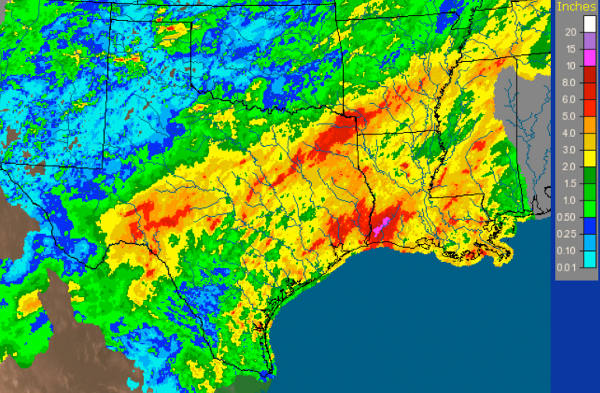
Most of Texas cited as winner because of tropical storm rain
Most of Texas received much-needed rain last week from Hurricane Ingrid and Tropical Storm Manuel, which pushed moisture northward from Mexico and the Gulf, improving agricultural prospects throughout the state. But reservoir levels tied the record low.
September 24, 2013

Two new weather and crop updates show significant improvements for Texas soil moisture conditions but a more dire prospect for reservoir levels occurred across the state.
Last Thursday, statewide reservoir levels tied the record low, at just 58.4 percent full. Even the “widespread rainfall received across much of the state late last week improved water storage only minimally, a scant 1 percent improvement, according to the latest report from the Texas Water Development Board (TWDB).
The reservoir levels may be the most disconcerting news. The current 59.4 percent level reflects a drop from 66 percent full just three months ago, 69 percent this time last year and 81 percent normally.
If you are enjoying reading this article, please check out Southwest Farm Press Daily and receive the latest news right to your inbox.
Drought status remained a concern as well with 95 percent of the state under some drought category. That improved from 96 percent from the previous week but was equal to three months ago and slightly worse than the 93 percent recorded at the same time last year.
For the good news, Robert Burns, with Texas AgriLife Extension media, reports that most areas of Texas came out “winners” following last week’s rainfall.
Burns notes the improved moisture conditions below in his weekly crop and weather report:
Most of the state received much-needed rain from Hurricane Ingrid and Tropical Storm Manuel, which pushed moisture northward from Mexico and the Gulf, improving agricultural prospects throughout the state, said Dr. Travis Miller, AgriLife Extension agronomist and Texas A&M University soil and crop sciences associate department head.
“And with this tropical storm system, it was particularly effective because we had a cold front pushing in from the north and holding the moisture there,” he said. “If you look at a map of the rainfall, there was a line from the Big Bend area all the way to Texarkana and south, where the cold front hit the Gulf moisture and dumped a lot of rain.”
Practically everyone got some rain. Some got only a trace, but receiving 3 to 4 inches was common, with 6 inches not that rare, according to National Weather Service records. Some areas along the coast got 10 inches or more.
Some areas got considerably less, according to the weather service and AgriLife Extension county agent weekly reports. In the South Plains and parts of West Texas, amounts varied from a trace to 1 inch, but that was welcomed too. In East Texas, while many counties got 6 inches or considerably more, San Augustine County reported it had gone 56 days without rain.
A few downsides accompanied the rain, including some delay of cotton harvest in the Coastal Bend and Blacklands areas. But even then, most of the cotton was already harvested, Miller said.
The moisture was a great boon on many fronts. In the northern parts of the state, it will help finish cotton. And throughout Texas, it will greatly improve the prospects for planting winter wheat and other forages for winter pasture. The added moisture should also be a big help to winter vegetables in South Texas and the Lower Rio Grande Valley.
For many livestock producers who have been cautious about rebuilding herds from historical lows despite high market prices, the September rains would no doubt promote optimism, Miller noted.
But he warned that as good as the rains are, historically, it’s no guarantee the drought cycle is broken.
“Last year, we had a rain on Sept. 29, then no rain until Christmas, and (consequently) we had no winter pasture,” he said. “This year will be analogous to that if we don’t see weather patterns develop to give more moisture.”
However, the tropical storm and hurricane season isn’t technically over until November, Miller said, which gives reason to continue to be optimistic, though cautiously so.
More information on the current Texas drought and wildfire alerts can be found on the AgriLife Extension Agricultural Drought Task Force website.
Also of Interest:
Timely rainfall makes Texas grain
You May Also Like



